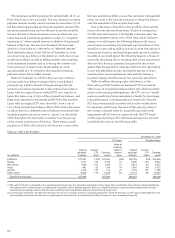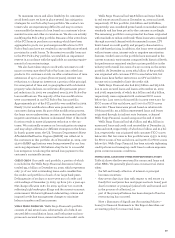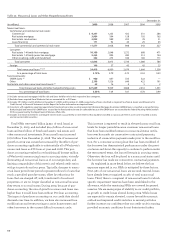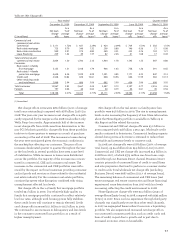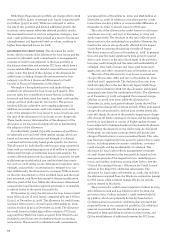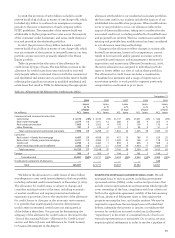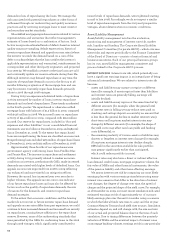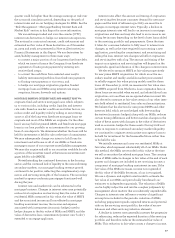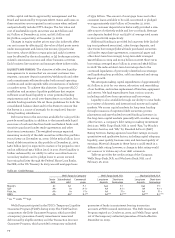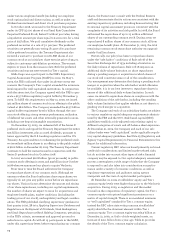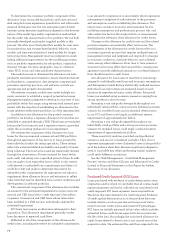Wells Fargo 2009 Annual Report Download - page 70
Download and view the complete annual report
Please find page 70 of the 2009 Wells Fargo annual report below. You can navigate through the pages in the report by either clicking on the pages listed below, or by using the keyword search tool below to find specific information within the annual report.
net of any gains on free-standing derivatives (economic
hedges) used to hedge MSRs. We may choose not to fully
hedge all of the potential decline in the value of our MSRs
resulting from a decline in interest rates because the potential
increase in origination/servicing fees in that scenario provides
a partial “natural business hedge.” An increase in interest rates
generally reduces the propensity for refinancing, extends the
expected duration of the servicing portfolio and therefore
increases the estimated fair value of the MSRs. However, an
increase in interest rates can also reduce mortgage loan
demand and therefore reduce origination income. In 2009,
a $1.5 billion decrease in the fair value of our MSRs and
$6.8 billion of gains on free-standing derivatives used to
hedge the MSRs resulted in a net gain of $5.3 billion. This
net gain was largely due to hedge-carry income reflecting
the current low short-term interest rate environment.
The price risk associated with our MSRs is economically
hedged with a combination of highly liquid interest rate
forward instruments including mortgage forward contracts,
interest rate swaps and interest rate options. All of the
instruments comprising the hedge are marked to market
daily. Because the hedging instruments are traded in highly
liquid markets, their prices are readily observable and are
fully reflected in each quarter’s mark to market. Quarterly
MSR hedging results include a combination of directional
gain or loss due to market changes as well as any carry
income generated. If the economic hedge is effective, its
overall directional hedge gain or loss will offset the change
in the valuation of the underlying MSR asset. Consistent with
our longstanding approach to hedging interest rate risk in the
mortgage business, the size of the hedge and the particular
combination of forward hedging instruments at any point
in time is designed to reduce the volatility of the mortgage
business’s earnings over various time frames within a range
of mortgage interest rates. Since market factors, the composi-
tion of the mortgage servicing portfolio and the relationship
between the origination and servicing sides of our mortgage
business change continually, the types of instruments used in
our hedging are reviewed daily and rebalanced based on our
evaluation of current market factors and the interest rate risk
inherent in our MSRs portfolio. Throughout 2009, our economic
hedging strategy generally used forward mortgage purchase
contracts that were effective at offsetting the impact of
interest rates on the value of the MSR asset.
Mortgage forward contracts are designed to pass the full
economics of the underlying reference mortgage securities to
the holder of the contract including both the directional gain
or loss from the forward delivery of the reference securities
and the corresponding carry income. Carry income represents
the contract’s price accretion from the forward delivery price to
the current spot price including both the yield earned on the
reference securities and the market implied cost of financing
during the period. The actual amount of carry income earned
on the hedge each quarter will depend on the amount of the
underlying asset that is hedged and the particular instruments
comprising the hedge. The level of carry income is driven by
the slope of the yield curve and other market driven supply
and demand factors impacting the specific reference securities.
A steep yield curve generally produces higher carry income
while a flat or inverted yield curve can result in lower or
potentially negative carry income. The level of carry income
is also impacted by the type of instrument used. In general,
mortgage forward contracts tend to produce higher carry
income than interest rate swap contracts. Carry income is
recognized over the life of the mortgage forward as a compo-
nent of the contract’s mark to market gain or loss. We expect
hedge carry income to remain strong as long as the yield
curve remains at historically steep levels and, in particular,
as long as market implied financing costs remain low.
During fourth quarter 2009, mortgage interest rates
increased, resulting in a valuation increase in the MSRs asset
due to slower prepayment speed assumptions and the corre-
sponding extension of the expected life of the MSRs asset, and
a directional valuation decline on the hedge position due to
the decrease in the price of the mortgage securities underlying
the mortgage forward purchase contract. However, because the
increase in mortgage rates during that quarter was relatively
small, and the yield on our mortgage forward purchase contracts
was relatively high compared with implied financing costs,
the carry income component of the hedge valuation change
exceeded the directional loss embedded in that valuation and
as a result, the total hedge result was positive even though the
value of the underlying MSR asset increased in the quarter.
Hedging the various sources of interest rate risk in mort-
gage banking is a complex process that requires sophisticated
modeling and constant monitoring. While we attempt to bal-
ance these various aspects of the mortgage business, there
are several potential risks to earnings:
• MSRs valuation changes associated with interest rate
changes are recorded in earnings immediately within the
accounting period in which those interest rate changes
occur, whereas the impact of those same changes in
interest rates on origination and servicing fees occur with
a lag and over time. Thus, the mortgage business could be
protected from adverse changes in interest rates over a
period of time on a cumulative basis but still display large
variations in income from one accounting period to the next.
• The degree to which the “natural business hedge” offsets
changes in MSRs valuations is imperfect, varies at different
points in the interest rate cycle, and depends not just
on the direction of interest rates but on the pattern of
quarterly interest rate changes.
• Origination volumes, the valuation of MSRs and hedging
results and associated costs are also affected by many
factors. Such factors include the mix of new business
between ARMs and fixed-rate mortgages, the relationship
between short-term and long-term interest rates, the
degree of volatility in interest rates, the relationship
between mortgage interest rates and other interest rate
markets, and other interest rate factors. Many of these
factors are hard to predict and we may not be able to
directly or perfectly hedge their effect.
• While our hedging activities are designed to balance
our mortgage banking interest rate risks, the financial
instruments we use may not perfectly correlate with
the values and income being hedged. For example, the


